written and photographed by Peter J. Ochs II and Mary L. Peachin
Mar 2001, Vol. 5 No. 5
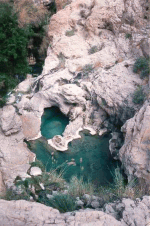 The 6-passenger land cruiser climbed up the roller coaster track into the rugged limestone canyon. We traveled about three miles into Wadi Tiwi. The stunning wadi is surrounded by a maze of large boulders and date palms. Tiwi is unique because of its perennial flow, most wadis in Oman are dry though out the year. Tranquil pools were contrasted by swirling eddies, and the melodious white noise of hidden cascades beckoned us to explore this mystic waterway.
The 6-passenger land cruiser climbed up the roller coaster track into the rugged limestone canyon. We traveled about three miles into Wadi Tiwi. The stunning wadi is surrounded by a maze of large boulders and date palms. Tiwi is unique because of its perennial flow, most wadis in Oman are dry though out the year. Tranquil pools were contrasted by swirling eddies, and the melodious white noise of hidden cascades beckoned us to explore this mystic waterway.
Leaving Muscat, the capital city of the Sultanate of Oman, we had traveled southeast along the coastline of the Gulf of Oman for two hours until we reached the mouth of Wadi Tiwi about mid-morning. Gentle sea breezes stirred the tall grass along the banks, sheep and goats foraged nearby. The floor of the wadi was covered with groves of date palm, banana, lime and mango trees, so dense they camouflaged the nearby villages of Hilat al Hisah, Harat Bidih and Aqr. At the mouth of the wadi, the gravel track was flat, but after traveling a short distance, running water began to cross the road. As we climbed higher into the jebels (mountains), the land cruiser had to carefully navigate between the large boulders
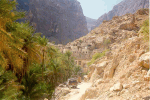 Suddenly we came upon an oasis-type place where waterfalls and cascades created natural swimming holes, some complete with built-in Jacuzzi-like eddies. After taking a brief dip to cool ourselves from the midday heat, we enjoyed a gourmet picnic on the banks of the wadi. We continued our adventure after fording the stream then climbing through another canyon. Our explorations were taking us through splendid and unspoiled scenery.
Suddenly we came upon an oasis-type place where waterfalls and cascades created natural swimming holes, some complete with built-in Jacuzzi-like eddies. After taking a brief dip to cool ourselves from the midday heat, we enjoyed a gourmet picnic on the banks of the wadi. We continued our adventure after fording the stream then climbing through another canyon. Our explorations were taking us through splendid and unspoiled scenery.
Once again, the track became a roller coaster as we climbed and descended up the walls of the valley. Shifting into low, we edged the vehicle on to a plateau where we found ourselves in another densely cultivated grove of date palms. An old tower next to the track helped us to identify the village as Samat. On top of this plateau, we enjoyed wonderful views of the wadi, surrounding villages, terraces and falaj (irrigation canals).
The road narrowed as we approach Mibam, a village perched on a ridge overlooking date palms. Children, acting as self-appointed sentinels, raced out to greet us. The 100 or so residents of this Islamic village welcomed us, although the women tended to be shy.
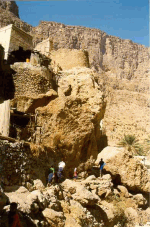 The villagers have learned to be tolerant of foreign lifestyles and habits through their religious Ibadhi upbringing. This small sect of Islam falls outside the two main schisms of Sunni and Shia, it is one the oldest established orthodoxy in Islam. The Ibadhis suffered a long history of persecution by other factions of Islam including the Kharajites, Shiites, and Wahaibi Fundamentalists. Today, they remain resilient and steadfast. The endearing optimism of the Ibadhi never fades in spite of living a rugged lifestyle in harsh conditions. They have tempered attitudes, and remain gracious and friendly.
The villagers have learned to be tolerant of foreign lifestyles and habits through their religious Ibadhi upbringing. This small sect of Islam falls outside the two main schisms of Sunni and Shia, it is one the oldest established orthodoxy in Islam. The Ibadhis suffered a long history of persecution by other factions of Islam including the Kharajites, Shiites, and Wahaibi Fundamentalists. Today, they remain resilient and steadfast. The endearing optimism of the Ibadhi never fades in spite of living a rugged lifestyle in harsh conditions. They have tempered attitudes, and remain gracious and friendly.
Mibam is constructed of mud-brick and stone with a few newer styled homes built of mixed concrete and cinder block. Streets wind like narrow alleys, houses are pitched on the slope of the canyon wall. Unveiled women in colorful dress peered curiously at us from balconies or windows.
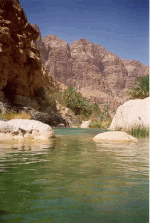 We passed near a stone arch in the center of the village as we followed a path toward the date plantation. In fifteen minutes the steep path leveled through a terrace where we traversed stone walls polished smooth by centuries of trodding.
We passed near a stone arch in the center of the village as we followed a path toward the date plantation. In fifteen minutes the steep path leveled through a terrace where we traversed stone walls polished smooth by centuries of trodding.
A concrete shelter near the main falaj irrigation inlet serves as a mosque where farmers pray during the day. Muslims are called to prayer five times a day: before sunrise (fajr), noon (dhuhr), mid-afternoon (asr), sunset (maghrib) and twilight (isha). The older men congregated after prayer to socialize while they wove palm fronds into baskets. We continued down the path until we found a break in the trees leading into a chasm that ended at the waterfalls of Shalat Al Mibam.
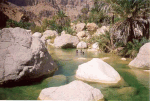 Water plunged 75 feet from the gorge crashing onto polished rock before it continued its flow to the next deep chasm. We reached the first pool by traversing a steep slab of rock imbedded with many footholds. At the lower pool, we discovered decorations of pebbles in concentric circles with spirals radiating outward from the center of the pool. We wondered if this symbolism celebrated the Eid holidays, a festive time following the somber and solemn month of fasting called Ramadân. Late afternoon shadows were approaching, so it was time to head back to the coast for our return to Muscat.
Water plunged 75 feet from the gorge crashing onto polished rock before it continued its flow to the next deep chasm. We reached the first pool by traversing a steep slab of rock imbedded with many footholds. At the lower pool, we discovered decorations of pebbles in concentric circles with spirals radiating outward from the center of the pool. We wondered if this symbolism celebrated the Eid holidays, a festive time following the somber and solemn month of fasting called Ramadân. Late afternoon shadows were approaching, so it was time to head back to the coast for our return to Muscat.
 Four-wheeling in Wadi Tiwi is a nice contrast from the arid desert found further inland. This four-wheeling adventure allows time for hiking and swimming, and also provides a taste of culture and village life. While there are other Omani wadis that are popular for hiking and swimming day trips, Wadi Tiwi seems to attract the more adventurous explorer.
Four-wheeling in Wadi Tiwi is a nice contrast from the arid desert found further inland. This four-wheeling adventure allows time for hiking and swimming, and also provides a taste of culture and village life. While there are other Omani wadis that are popular for hiking and swimming day trips, Wadi Tiwi seems to attract the more adventurous explorer.
For further information: read Maverick Guide to Oman by Peter J. Ochs II, e-mail Mark Tours at [email protected], visit his web site at www.markrentacar.com/marktours/index.html or [email protected]
The City of Muscat
Written and photographed by Mary L. Peachin
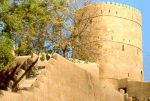 The Gulf of Oman gently laps the white sandy beaches of Muscat. The capital of the Sultanate of Oman, Muscat is the gateway to this relatively unknown country located in the southwest corner of the Middle East. Geographically about the size of Kansas, Oman has played an historic role serving as the guardian of the strategic shipping channel of the Strait of Hormuz. Oil-laden freighters haul shipments of the precious cargo from Iran, Iraq, and Saudi Arabia passing southward through the strategic Strait enroute to the Arabian Sea and the Persian Gulf.
The Gulf of Oman gently laps the white sandy beaches of Muscat. The capital of the Sultanate of Oman, Muscat is the gateway to this relatively unknown country located in the southwest corner of the Middle East. Geographically about the size of Kansas, Oman has played an historic role serving as the guardian of the strategic shipping channel of the Strait of Hormuz. Oil-laden freighters haul shipments of the precious cargo from Iran, Iraq, and Saudi Arabia passing southward through the strategic Strait enroute to the Arabian Sea and the Persian Gulf.
Since the beginning of the first century AD, the waterway has played an important role in the history of the country. The Portuguese conquered and guarded the strategic waterway building forts that still loom as sentinels of the port of Muscat. In 1650, Imam Sultan Bin Saif drove the Portuguese from Muscat creating an independent country. Once freed from the Portuguese, Omani merchants sailed their wooden dhows trading spices, ivory, slaves, and arms along the coast of East Africa. Oman’s alliance with Britain protected its independence.
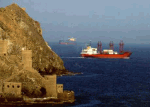 During the next 300 years, not much is known of the history of Oman. The changing point came in 1970 when Sultan Qaboos Bin Said took power. Cautiously, the Sultan brought his country out of isolation and into the 20th century by welcoming visitors.
During the next 300 years, not much is known of the history of Oman. The changing point came in 1970 when Sultan Qaboos Bin Said took power. Cautiously, the Sultan brought his country out of isolation and into the 20th century by welcoming visitors.
Visas are issued for round-trip travel to Seeb International airport; arrival and departure to and from the same destination is required. Muscat is a sparkling city of stark-white buildings edged by the turquoise waters of the Gulf. The Sultan has challenged the residents of Muscat to be environmentally conscious, and the cleanliness of the city is immediately apparent.
Traditional dress is the standard. Men dress in dishdashas, a floor-length shirt, and wear a turban with an intricate pattern embroidered around its edges. Women wear abayas (all-enveloping black cloak.) They cover their faces either with the cloak (there’s a gauze panel so they can see out) or a veil. In the some areas of the countryside women are masked.
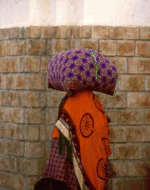 The Sultan’s Al Alam Palace, its green lawns extending to waters of the Gulf, is located between two remaining Portuguese forts, Jalali and Mirani. Visitors to Jalali must climb the narrow staircase outside the three-foot retaining walls. The inner courtyard has a dungeon, a darkened hole in the ground, which most prisoners did not survive.
The Sultan’s Al Alam Palace, its green lawns extending to waters of the Gulf, is located between two remaining Portuguese forts, Jalali and Mirani. Visitors to Jalali must climb the narrow staircase outside the three-foot retaining walls. The inner courtyard has a dungeon, a darkened hole in the ground, which most prisoners did not survive.
Call to prayer echoes from the nearby mosque five times each day and it is not unusual for the Omani to put a meeting on hold during prayer. The religious influence in Oman is the Ibadhi sect of Islam, and the faithful take their worship seriously. Visitors are expected to join the fast in public places during the holy month of Ramadan. Islam forbids the drinking of alcohol (exceptions are made in tourist hotels.) Women are advised to dress conservatively with long sleeves and loose pants. Veiled women should not be photographed.
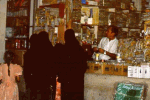 Hours can be spent wandering the maze of alley-size streets of the Mutrah souk. The Dhofar coast in southern Oman is home to a small tree that produces a precious resin known as frankincense. Bedouin women sell the incense along with a ceramic jar and special charcoal briquettes. Other streets offer shops where gold and silver is sold by the ounce. Veiled woman can be observed shopping for clothes and colorful patterns of material.
Hours can be spent wandering the maze of alley-size streets of the Mutrah souk. The Dhofar coast in southern Oman is home to a small tree that produces a precious resin known as frankincense. Bedouin women sell the incense along with a ceramic jar and special charcoal briquettes. Other streets offer shops where gold and silver is sold by the ounce. Veiled woman can be observed shopping for clothes and colorful patterns of material.
A visit to Oman is not inexpensive. The Omani Riyal is valued at more than twice the U.S. dollar. Visitors wanting to splurge will stay in the ornate Al Bustan Palace Hotel. The Batinah Coast, a 200 mile band where Oman’s capital of Muscat is located in the lower right corner of the Arabian peninsula, may be a country of hot, arid desert and wadis (dry rivers) but its capital city sparkles.
For further information: e-mail [email protected] or read Maverick Guide to Oman by Peter J. Ochs II
